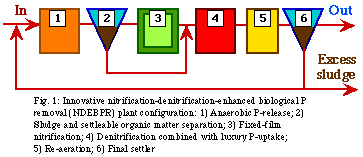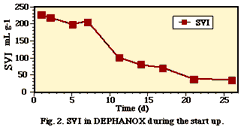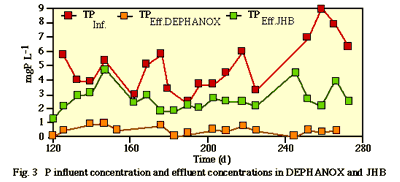Biological Phosphorus Removal...
Introduction...
Biological P removal is often considered to be unstable and unreliable by treatment plant operators and designers. This is because readily biodegradable COD/N and P ratios in the sewage are often low and may fluctuate enough to affect nutrient removal performances. Concerned with this instability, Wanner et al. (1991), Jeniceck et al. (1994) Bortone et al. (1994)
and Kuba et al. (1993) have investigated the integration of denitrifying dephosphatation micro-organisms in P and N removal treatment plants.
In most common modifications of nutrient removal activated sludge plants, the anaerobic zone is placed ahead of the
anoxic zone. Thus, the organic substrate sequestered by Polyphosphate Accumulating Organisms (PAO) under anaerobic
conditions is not available for denitrifiers under anoxic condition. However, this would be the case only when PAO are completely different from denitrifiers. The occurrence of denitrifying phosphorus removing bacteria (DPB) has been clearly demonstrated in several studies (Kern-Jespersen and Henze M., 1993; Jenicek et al. 1993, Kuba et al. 1993, Bortone et al. 1996). It has been shown that DPB have similar capacities and characteristics as fully aerobic PAO.
Plant configurations that exert selective pressure in favour of DPB are strongly recommended, since the competition between PAO and denitrifiers can be drastically reduced. Recently, Kuba et al. (1996) have reported a stoichiometric mass balance of the required COD, consumed oxygen and produced sludge for P and N removal in single sludge conventional systems, alternating anaerobic/anoxic/aerobic conditions, and in two-sludge systems, alternating anaerobic/anoxic condition with a separated oxic phase. From the stoichiometric calculation, it follows that, for the same amount of removed nutrient, 50%of the COD requirement, 30% of the oxygen consumption and and 50% of the sludge production can be saved using the two-sludge systems.
Moreover,these kind of plants are particularly suitable for low COD/TKN ratio wastewater, where the lack of carbon affects the nutrient removal efficiency. It has been experimentally proved that optimal performances can be obtained with only 3.4:1 COD/N ratio (Kuba et al. 1996), while in conventional systems COD/N ratio should be higher than 4.5:1, up to 8.6:1 to take into account the aerobic COD "loss" in oxic condition.
On the basis of those considerations, the DEPHANOX process (Fig. 1) was set up.
 Operation of the "DEPHANOX" Process...
Raw municipal wastewater is introduced into anaerobic tank (1) where phosphate is released from Poly-P bacteria cells and most of organic substrate is bio-sorbed in activated sludge flocs and accumulated/stored in bacteria cells.
A downstream settler (2) separates activated sludge with organic substrate (both extra and intracellular) from ammonia-rich supernatant. The liquid stream then goes to a biofilm reactor (3) where nitrification occurs. The organic-substrate-rich sludge bypasses nitrification and is resuspended with the nitrified effluent from (3) in the anoxic stage (4). Here nitrates are removed by denitrifying bacteria and also utilised by Poly-P bacteria as electron acceptors for enhanced P-uptake. A post-aeration step (5) allows nitrogen gas stripping from the sludge and favours a complete regeneration of Poly-P bacteria (complete oxidation of intracellular storage products like PHB) before final settling (6).
Benefits of the Process...
This process proved to be very efficient because of the utilisation of organic substrate either for phosphorus
and for nitrogen removal. The process eliminates the competition for organic substrates among Poly-P organisms
and denitrifiers as well as the problem of overgrowing of slow nitrifiers by faster organotrophs, typical of activated sludge. Other benefits for P and N removal of DEPHANOX in comparison with single-sludge systems can be summarised as
follows :
Operation of the "DEPHANOX" Process...
Raw municipal wastewater is introduced into anaerobic tank (1) where phosphate is released from Poly-P bacteria cells and most of organic substrate is bio-sorbed in activated sludge flocs and accumulated/stored in bacteria cells.
A downstream settler (2) separates activated sludge with organic substrate (both extra and intracellular) from ammonia-rich supernatant. The liquid stream then goes to a biofilm reactor (3) where nitrification occurs. The organic-substrate-rich sludge bypasses nitrification and is resuspended with the nitrified effluent from (3) in the anoxic stage (4). Here nitrates are removed by denitrifying bacteria and also utilised by Poly-P bacteria as electron acceptors for enhanced P-uptake. A post-aeration step (5) allows nitrogen gas stripping from the sludge and favours a complete regeneration of Poly-P bacteria (complete oxidation of intracellular storage products like PHB) before final settling (6).
Benefits of the Process...
This process proved to be very efficient because of the utilisation of organic substrate either for phosphorus
and for nitrogen removal. The process eliminates the competition for organic substrates among Poly-P organisms
and denitrifiers as well as the problem of overgrowing of slow nitrifiers by faster organotrophs, typical of activated sludge. Other benefits for P and N removal of DEPHANOX in comparison with single-sludge systems can be summarised as
follows :
- Smaller reactor volumes.
- Separate optimisation for P and N removal possible.
- Lower energy requirements.
- Utilisation of oxygen for nitrification only.
- Minimal utilisation of oxygen for P removal.
- No large recirculation.
- Minimal loss of COD by aerobic oxidation.
A bottleneck is represented by NH4-N residues in the sludge bypass stream. If NH4-N concentration is balanced with ammonia requirement for growth in the anoxic zone, nitrogen removal is complete, otherwise NH4-N
may appear in the effluent. The lower the sludge bypass flow rate, the higher is the N removal efficiency. Very low sludge bypass rates are made possible because of the very high settleability of the activated sludge in this type of process configuration (alternating anaerobic/anoxic conditions only).
It has been demonstrated (Sorm et al., 1996, Bortone et al. 1996), that combined kinetic and metabolic selection improves sludge settleability. In spite of the fact that DEPHANOX was started up with an activated sludge characterised by high abundance of filamentous micro-organisms (Microthrix parvicella), a rapid decrease of SVI values was recorded during the start up period and, for the entire experiment, SVI-values have been usually lower than 50 mL/g (Fig.2).
 Operational Data...
A three year experimental comparison of the DEPHANOX efficiency with another more conventional NDEBPR configuration, as the JHB configuration, has been carried out. The comparison tests were carried out with a low influent COD/TKN ratio (4.5:1).
In Figure 3, phosphorus influent/effluent parameters are shown. The most significant difference was in P removal. The low influent COD/TKN ratio did not allow the complete depletion of nitrates in the JHB anaerobic compartment, that worked in
fact as anoxic reactor. Full nitrification capacity was always reached, as well witnessed by very low effluent ammonia concentrations. Differences were observed in effluent nitrate concentration: in average values, they were higher in the DEPHANOX effluent than in JHB. DEPHANOX configuration allowed to keep effluent P concentrations always lower than 1 mg/L, while JHB effluent presented significantly higher values.
Operational Data...
A three year experimental comparison of the DEPHANOX efficiency with another more conventional NDEBPR configuration, as the JHB configuration, has been carried out. The comparison tests were carried out with a low influent COD/TKN ratio (4.5:1).
In Figure 3, phosphorus influent/effluent parameters are shown. The most significant difference was in P removal. The low influent COD/TKN ratio did not allow the complete depletion of nitrates in the JHB anaerobic compartment, that worked in
fact as anoxic reactor. Full nitrification capacity was always reached, as well witnessed by very low effluent ammonia concentrations. Differences were observed in effluent nitrate concentration: in average values, they were higher in the DEPHANOX effluent than in JHB. DEPHANOX configuration allowed to keep effluent P concentrations always lower than 1 mg/L, while JHB effluent presented significantly higher values.
 It should be noted that in the DEPHANOX process two settlers are used instead of one as in conventional configurations. This might make this configuration uncompetitive with regards to the high investment cost, which might not be justified by the higher efficiency that can be obtained. Therefore, configuration up-grading was needed to reduce reactor volume and related investment costs. This has been realised by substituting the anaerobic reactor and the first settler with a "UASB-like" reactor that, due to the very low SVI of the sludge always obtained with this configuration, can easily handle the function of separating a well clarified COD-poor supernatant from a dense COD-rich sludge.
It should be noted that in the DEPHANOX process two settlers are used instead of one as in conventional configurations. This might make this configuration uncompetitive with regards to the high investment cost, which might not be justified by the higher efficiency that can be obtained. Therefore, configuration up-grading was needed to reduce reactor volume and related investment costs. This has been realised by substituting the anaerobic reactor and the first settler with a "UASB-like" reactor that, due to the very low SVI of the sludge always obtained with this configuration, can easily handle the function of separating a well clarified COD-poor supernatant from a dense COD-rich sludge.
The first experimental results have demonstrated the high solid retention capacity of the reactor and the high separation efficiency. On the bottom of the anaerobic reactor the TSS concentration was over 35 g/L, within the sludge blanket - at the height of the sludge exit - it was of about 15 g/L, while at the supernatant effluent level it was of few tens of mg/L.
It can be estimated that solid retention time in the UASB type anaerobic reactor was around 1.5 days. So long solid retention time should allow anaerobic hydrolysis as well as fermentation of slowly biodegradable COD, that might contribute positively to the nutrient removal process. Off-gas analyses did not show any significant trace of methane, indicating that methanogenesis was not active, despite the fact that oxidation reduction potential was lower than -200 mV in the sludge blanket.
Conclusions...
DEPHANOX configuration allows a very efficient phosphate uptake with simultaneous denitrification. DEPHANOX allows a
constant high efficiency of P removal even operating with low COD/TKN ratio wastewater, while other configuration (JHB)
can fail. Modified DEPHANOX offers comparable efficiency with much lower reactor volume. This can make the configuration extremely competitive even with regards to the investment costs. On the basis of these very promising results, ENEA is currently designing and constructing a transportable pilot plant using the modified DEPHANOX configuration for field
studies.




